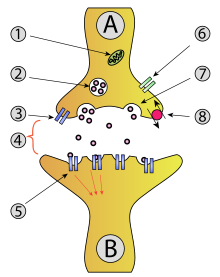


Anamino acid neurotransmitter is an amino acid which is able to transmit a nerve message across a synapse. Neurotransmitters (chemicals) are packaged into vesicles that cluster beneath the axon terminal membrane on the presynaptic side of a synapse in a process called endocytosis.[1]
Amino acid neurotransmitter release (exocytosis) is dependent upon calcium Ca2+ and is a presynaptic response.
Excitatory amino acids (EAA) will activate post-synaptic cells.[2] inhibitory amino acids (IAA) depress the activity of post-synaptic cells.[2]
| Amino acid[3][4] | Excitatory or inhibitory |
|---|---|
| Aspartic acid | Excitatory |
| β-alanine | Inhibitory |
| Cysteine | Excitatory |
| GABA (adult human brain) | Inhibitory (adult); excitatory (developing) |
| Glycine | Inhibitory |
| Glutamic acid | Excitatory |
| Homocysteine | Excitatory |
| Taurine | Inhibitory |
|
| |||||||||||||||||||||||
|---|---|---|---|---|---|---|---|---|---|---|---|---|---|---|---|---|---|---|---|---|---|---|---|
| Amino acid-derived |
| ||||||||||||||||||||||
| Lipid-derived |
| ||||||||||||||||||||||
| Nucleobase-derived |
| ||||||||||||||||||||||
| Vitamin-derived |
| ||||||||||||||||||||||
| Miscellaneous |
| ||||||||||||||||||||||
|
| |||||||||||
|---|---|---|---|---|---|---|---|---|---|---|---|
| General topics |
| ||||||||||
| By properties |
| ||||||||||
|
| |||||||||||
|
| |||||||||||||
|---|---|---|---|---|---|---|---|---|---|---|---|---|---|
| Signaling pathways |
| ||||||||||||
| Agents |
| ||||||||||||
| By distance |
| ||||||||||||
| Other concepts |
| ||||||||||||
|
| |||||||||
|---|---|---|---|---|---|---|---|---|---|
| Acetylcholine |
| ||||||||
| BA/M |
| ||||||||
| AA |
| ||||||||